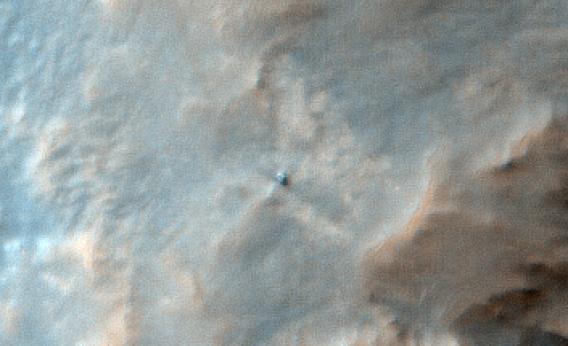Create a free profile to get unlimited access to exclusive videos, sweepstakes, and more!
Found Opportunity

It’s actually rather amazing what you can see from orbit. Once you’re off the ground, above it, your perspective changes, and you can put things in context. Signs of civilization can shrink down to almost nothing compared with the glory of nature, making them difficult to spot.
For example, peruse this image taken by a satellite:
Can you even see any signs of human activity there on the surface?
Oh, wait a second. My apologies. I forgot to mention: That’s not the surface of Earth … it’s the surface of Mars. And the signs of humanity you see there are really just a single sign.
Can you spot that blip right in the center? That’s the Mars rover Opportunity!
It’s only about 2.3 x 1.6 meters (7.5 x 5.2 feet) in size, so it’s just a few pixels across as seen by the HiRISE camera on the Mars Reconnaissance Orbiter. If the scientists and engineers programming the probe didn’t know exactly where Opportunity was, it would be impossible to find! But we know exactly where all our working hardware is on Mars, and we know exactly where the orbiting cameras point, making it far simpler to get pictures of the land-bound rovers.
Opportunity is seen here at what’s called Solander Point, where it found that odd rock nicknamed the “jelly doughnut.” The rock suddenly appeared next to the rover, when earlier images taken by Opportunity showed bare ground. That was quite a mystery, but it’s now pretty clear that the rock was a piece of a larger one broken off by one of the rover’s wheels. Images like this one from HiRISE are pretty useful when things like this happen; it shows no fresh craters nearby, making it unlikely the rock was ejected by a small impact.
But for those of us back home who don’t study Mars for a living (and, I’d wager, even for those who do), images like this are still a thrill. As my friend Emily Lakdawalla puts it, “Seeing a spacecraft on the surface of a planet from another spacecraft never gets old.”
She’s right. It’s a great reminder that we humans are amazing when we want to be. We can, in a short time, go from creating myths about lights in the sky to landing on them and discovering their truths for ourselves.


























